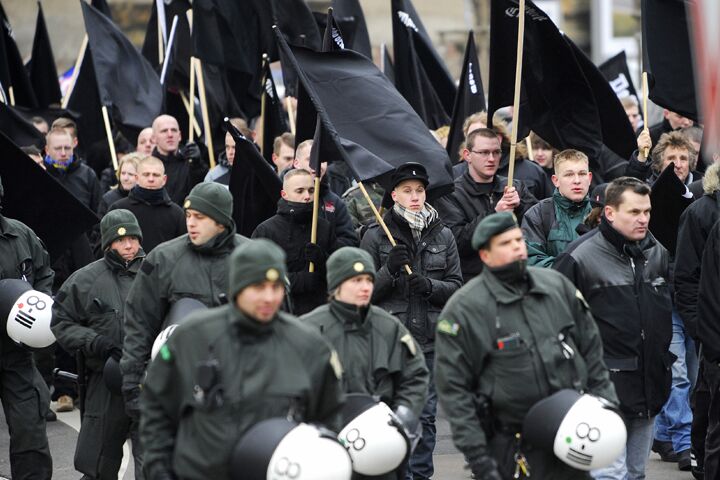
Neo-Nazis March in Dresden
Six thousand neo-Nazis descended upon Dresden in eastern Germany last weekend in one of the largest extremist gatherings since World War ii. The Dresden march has become an annual event for German neo-Nazis trying to twist history to show that Germany was the real victim of the war.
Around 10,000 anti-fascists turned up to protest against the Nazis.
The number of neo-Nazis attending the march almost doubled over last year, causing great concern among some in Germany. “The demonstration is a dramatic sign and shows that we aren’t sowing unnecessary hysteria and panic when we warn about the growing danger of the far right,” said Stephan Kramer, the general secretary of the Central Council of Jews in Germany.
“The march is a revival of German far-right megalomania and extreme nationalism,” Hajo Funke, an expert on neo-Nazis at the Free University in Berlin, told Bloomberg. “The far right’s strength isn’t in parliament, but rather in a rightist and neo-Nazi subculture that’s been unbroken since the 1990s.”
“It’s horrible—I’ve never seen anything like this before,” 58-year-old Dresdener Frank Samol said as he watched the Nazis march through the city center. “The right wing is exploiting this event to put on a big show.”
The march was held on the 64th anniversary of the Allied firebombing of Dresden. The Nazis call the attack a “bomb holocaust,” claiming that hundreds of thousands of people died and trying to put the attack on the same level as Germany’s systematic and industrialized homicide of 6 million Jews. “They’re trying to link the victims of Dresden with the victims of Auschwitz,” said Funke. “They represent a call for reviving the German Reich, anti-Americanism and anti-Semitism.”
More realistic estimates put the Dresden death toll at 25,000. But many myths about the bombing persist. “Many otherwise respectable people in Dresden and elsewhere, many of whom grew up with the post-war myths, continue to believe in the inflated casualty figures and in the criminality of the Allied bombing campaign,” British historian Frederick Taylor said an interview with Spiegel Online.
German historian Jörg Friedrich promotes these kinds of myths. And his books are bestsellers. Even retired Chief Commander of the German Armed Forces Klaus Naumann has endorsed these kinds of views.
In spite of appearances, this type of revisionist history is dangerously close to the mainstream inside Germany. That is why these kinds of marches are attracting record numbers. As the German economy collapses and people get more desperate, watch for a continued resurgence in right-wing views not only in Germany but across Europe.
